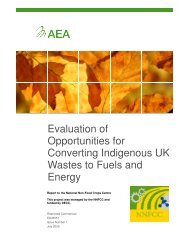Greenhouse gas conversion factors for company reporting
Greenhouse gas conversion factors for company reporting
Greenhouse gas conversion factors for company reporting
You also want an ePaper? Increase the reach of your titles
YUMPU automatically turns print PDFs into web optimized ePapers that Google loves.
2012 Guidelines to Defra / DECC's GHG Conversion Factors <strong>for</strong> Company Reporting<br />
Annex 1 - Converting from fuel use to carbon dioxide equivalent emissions<br />
Last updated: Apr-12<br />
How to use this Annex<br />
1) Identify the amount of fuel used <strong>for</strong> each fuel type<br />
2) Identify the units. Are you measuring fuel use in terms of mass, volume or energy?<br />
3) If you are measuring fuel use in terms of energy is your unit of measurement net energy or gross energy? (Please see paragraph below on net and gross energy. In the event that this is unclear you<br />
should contact your fuel supplier).<br />
4) Identify the appropriate <strong>conversion</strong> factor that matches the unit you are using. If you cannot find a factor <strong>for</strong> that unit, Annex 12 gives guidance on converting between different units of mass, volume,<br />
length and energy.<br />
5) Multiply the amount of fuel used by the <strong>conversion</strong> factor to get total emissions in kilograms of carbon dioxide equivalent (kg CO 2 e). The excel spreadsheet calculates this automatically following your<br />
entry of the amount of fuel used into the appropriate box.<br />
Note: In the UK biofuels are added to virtually all of the transport fuel sold by filling stations (and by most fuel wholesalers) and this has the effect of slightly reducing the greenhouse <strong>gas</strong> emissions of<br />
the fuel. This is reflected in the emission <strong>factors</strong> below. For fuel purchased at filling stations or obtained from private commercial refuelling you should use the factor labelled "average biofuel blend"<br />
unless you know the biofuel content is higher or lower than average. In this latter case, if you are purchasing pure petrol or diesel which you know has not been blended with biofuels then you should<br />
use the factor labelled "100% mineral fuel", or alternatively use the bespoke biofuel blend calculations provided in Annex 9, Table 9b.<br />
Four tables are presented here, the first of which provides emission <strong>factors</strong> by unit mass, and the second by unit volume. Tables 1c and 1d provide emission <strong>factors</strong> <strong>for</strong> energy on a Gross and Net CV<br />
basis respectively; emission <strong>factors</strong> on a Net CV basis are higher (see definition of Gross CV and Net CV in italics below). It is important to use the correct emission factor, otherwise emissions<br />
calculations will over- or under-estimate the results. If you are making calculations based on energy use, you must check (e.g. with your fuel supplier) whether these values were calculated on a Gross<br />
CV or Net CV basis and use the appropriate factor. Natural Gas consumption figures quoted in kWh by suppliers in the UK are generally calculated (from the volume of <strong>gas</strong> used) on a Gross CV basis -<br />
see Transco website: http://www.transco.co.uk/services/cvalue/cvinfo.htm. There<strong>for</strong>e the emission factor in Table 1c (Gross CV basis) should be used by default <strong>for</strong> calculation of emissions from<br />
Natural Gas in kWh, unless your supplier specifically states they have used Net CV basis in their calculations instead.<br />
Gross CV or higher heating value (HHV) is the CV under laboratory conditions. Net CV or 'lower heating value (LHV) is the useful calorific value in typical real world conditions (e.g. boiler plant). The<br />
difference is essentially the latent heat of the water vapour produced (which can be recovered in laboratory conditions).<br />
Annex 1 Scopes & Boundaries:<br />
Scope 1: Direct emissions of CO 2 , CH 4 and N 2 O from the combustion of fuel.<br />
Scope 3: Indirect emissions associated with the extraction and transport of primary fuels as well as the refining, distribution, storage and retail of finished fuels.<br />
Emission <strong>factors</strong> are based on data from the JEC Well-To-Wheels study, <strong>for</strong> further in<strong>for</strong>mation see the following links:<br />
http://iet.jrc.ec.europa.eu/about-jec/<br />
http://iet.jrc.ec.europa.eu/about-jec/downloads<br />
How were these <strong>factors</strong> calculated?<br />
For further explanation on how these emission <strong>factors</strong> have been derived, please refer to the GHG <strong>conversion</strong> factor methodology paper available here:<br />
http://www.defra.gov.uk/environment/economy/business-efficiency/<strong>reporting</strong>/<br />
Page 7 of 54








